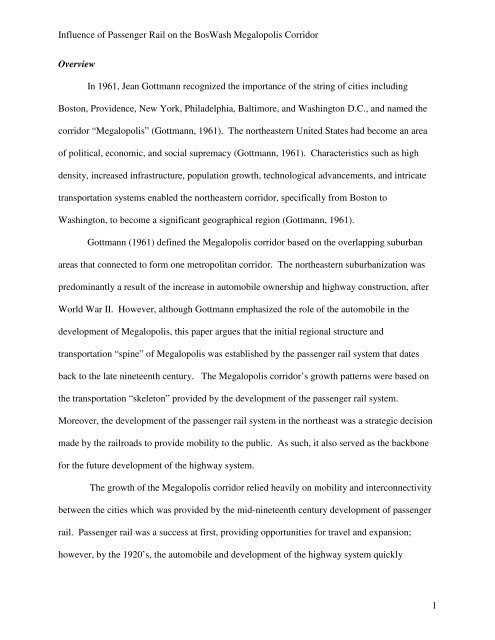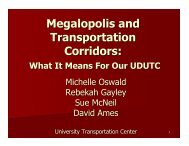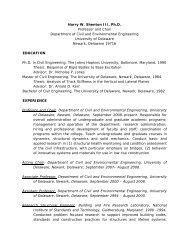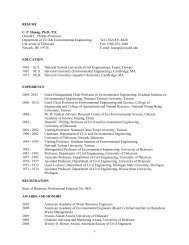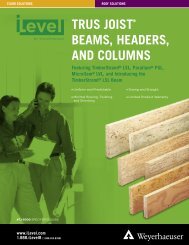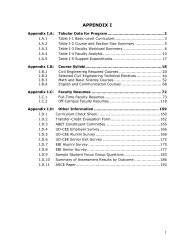Influence of Passenger Rail on the BosWash Megalopolis Corridor ...
Influence of Passenger Rail on the BosWash Megalopolis Corridor ...
Influence of Passenger Rail on the BosWash Megalopolis Corridor ...
You also want an ePaper? Increase the reach of your titles
YUMPU automatically turns print PDFs into web optimized ePapers that Google loves.
<str<strong>on</strong>g>Influence</str<strong>on</strong>g> <str<strong>on</strong>g>of</str<strong>on</strong>g> <str<strong>on</strong>g>Passenger</str<strong>on</strong>g> <str<strong>on</strong>g>Rail</str<strong>on</strong>g> <strong>on</strong> <strong>the</strong> <strong>BosWash</strong> <strong>Megalopolis</strong> <strong>Corridor</strong><br />
Overview<br />
In 1961, Jean Gottmann recognized <strong>the</strong> importance <str<strong>on</strong>g>of</str<strong>on</strong>g> <strong>the</strong> string <str<strong>on</strong>g>of</str<strong>on</strong>g> cities including<br />
Bost<strong>on</strong>, Providence, New York, Philadelphia, Baltimore, and Washingt<strong>on</strong> D.C., and named <strong>the</strong><br />
corridor “<strong>Megalopolis</strong>” (Gottmann, 1961). The nor<strong>the</strong>astern United States had become an area<br />
<str<strong>on</strong>g>of</str<strong>on</strong>g> political, ec<strong>on</strong>omic, and social supremacy (Gottmann, 1961). Characteristics such as high<br />
density, increased infrastructure, populati<strong>on</strong> growth, technological advancements, and intricate<br />
transportati<strong>on</strong> systems enabled <strong>the</strong> nor<strong>the</strong>astern corridor, specifically from Bost<strong>on</strong> to<br />
Washingt<strong>on</strong>, to become a significant geographical regi<strong>on</strong> (Gottmann, 1961).<br />
Gottmann (1961) defined <strong>the</strong> <strong>Megalopolis</strong> corridor based <strong>on</strong> <strong>the</strong> overlapping suburban<br />
areas that c<strong>on</strong>nected to form <strong>on</strong>e metropolitan corridor. The nor<strong>the</strong>astern suburbanizati<strong>on</strong> was<br />
predominantly a result <str<strong>on</strong>g>of</str<strong>on</strong>g> <strong>the</strong> increase in automobile ownership and highway c<strong>on</strong>structi<strong>on</strong>, after<br />
World War II. However, although Gottmann emphasized <strong>the</strong> role <str<strong>on</strong>g>of</str<strong>on</strong>g> <strong>the</strong> automobile in <strong>the</strong><br />
development <str<strong>on</strong>g>of</str<strong>on</strong>g> <strong>Megalopolis</strong>, this paper argues that <strong>the</strong> initial regi<strong>on</strong>al structure and<br />
transportati<strong>on</strong> “spine” <str<strong>on</strong>g>of</str<strong>on</strong>g> <strong>Megalopolis</strong> was established by <strong>the</strong> passenger rail system that dates<br />
back to <strong>the</strong> late nineteenth century. The <strong>Megalopolis</strong> corridor’s growth patterns were based <strong>on</strong><br />
<strong>the</strong> transportati<strong>on</strong> “skelet<strong>on</strong>” provided by <strong>the</strong> development <str<strong>on</strong>g>of</str<strong>on</strong>g> <strong>the</strong> passenger rail system.<br />
Moreover, <strong>the</strong> development <str<strong>on</strong>g>of</str<strong>on</strong>g> <strong>the</strong> passenger rail system in <strong>the</strong> nor<strong>the</strong>ast was a strategic decisi<strong>on</strong><br />
made by <strong>the</strong> railroads to provide mobility to <strong>the</strong> public. As such, it also served as <strong>the</strong> backb<strong>on</strong>e<br />
for <strong>the</strong> future development <str<strong>on</strong>g>of</str<strong>on</strong>g> <strong>the</strong> highway system.<br />
The growth <str<strong>on</strong>g>of</str<strong>on</strong>g> <strong>the</strong> <strong>Megalopolis</strong> corridor relied heavily <strong>on</strong> mobility and interc<strong>on</strong>nectivity<br />
between <strong>the</strong> cities which was provided by <strong>the</strong> mid-nineteenth century development <str<strong>on</strong>g>of</str<strong>on</strong>g> passenger<br />
rail. <str<strong>on</strong>g>Passenger</str<strong>on</strong>g> rail was a success at first, providing opportunities for travel and expansi<strong>on</strong>;<br />
however, by <strong>the</strong> 1920’s, <strong>the</strong> automobile and development <str<strong>on</strong>g>of</str<strong>on</strong>g> <strong>the</strong> highway system quickly<br />
1


